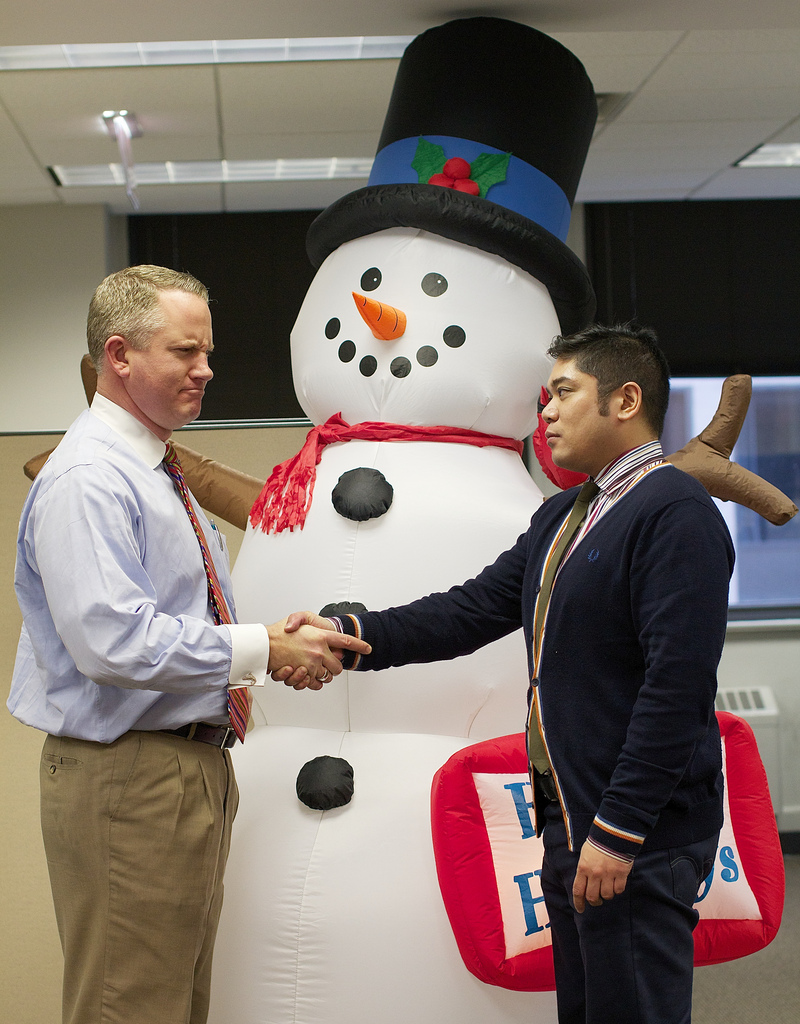It is hard to argue against the sentiment that Boston is a college city. According to data from the United States Census Bureau, there are approximately 250,000 college students attending school within the Boston area at 85 different institutions of higher learning.[1] Boston leads the nation in per capita student enrollment, and The Bureau of Labor Statistics claims that Boston higher education institutions employ more than 70,000 people.[2] It is the “Athens of America.”
Higher education is one half of the city’s economic spine, combining with the health services industry to make Boston a research juggernaut. Taking advantage of and servicing this market with the introduction of an aggressive and far-reaching Massachusetts Bay Transportation Authority (MBTA or T) unlimited university pass program would serve the citizens of the city by affordably mobilizing the city’s bright young minds, increasing Boston’s attractiveness as a higher education destination, increasing the accessibility of all of the city’s neighborhoods to college students and therefore increasing the chances they stay after graduation, and providing enough revenue for the MBTA to fund overnight service and the improvement of other services.
Not only would the extended overnight service funded by the university pass program spur the city’s economic growth, improve accessibility to the public, and serve a wider customer base such as late night industry workers, nightlife customers, and travelers, it can be paid for by the hundreds of thousands of students who call Boston home and the universities that define a significant part of the city’s image. In addition, the increased use of the T, both by the college population and by those who otherwise would have used a car late at night, will improve safety and decrease carbon emissions. Other such programs have been implemented in Milwaukee, Chicago, and San Francisco.[3] It is time for Boston to join the club.
This proposed university pass program model has its origins in the city of Milwaukee and has subsequently been adopted by the public transportation agencies in the cities of Chicago and San Francisco.[4] The major features of each city’s program are highlighted in Table 1. The premise of each program is that individual universities opt to buy into the program with the promise that, at a steeply discounted rate, they will purchase unlimited university transportation passes for 100% of their undergraduate students.[5] Typically, most of the participating institutions shift the cost of the pass directly onto the students through mandatory student activity fees or very minor tuition hikes.[6]
These programs have seen massive success. The Chicago program has grown so large, with over 50 member institutions, that the Chicago Transit Authority (CTA) has established a dedicated department that both manages and administers all the aspects of the program while also reaching out to schools and students to record feedback and expand the program’s reach.[7] Based on the efforts of the CTA and the program’s popularity, the CTA netted a profit of $25 million in 2012.[8]

Officials in the three cities were once worried that a rapid expansion of the program would result in system overload. However, they have since realized that the program has only increased the efficiency of their respective transit offerings due to the daily use schedules of most students. A CTA study on the matter revealed that 70 percent of student trips on the transit system occurred during non-peak hours, solidifying the fact that students, especially in urban areas, have different travel patterns than the average transit customer.[9] None of the cities have experienced any overcapacity problems, as was once feared.
The program has significantly spiked student ridership in all three cities. A study done by the University of Wisconsin in Milwaukee (UWM) showed that Milwaukee’s pilot program resulted in a 10 percent increase in student transit use, complementing a 10 percent decrease in student driving in the first year alone.[10] Additionally, the UWM research showed that within the first two years of the program, vehicle miles travelled decreased by 5.1 million miles and carbon emissions dropped by 20 percent compared to the output of UWM students before the implementation of the program.[11] In Chicago, the CTA saw a 7 percent system-wide ridership increase in the program’s first year.[12] Overall, all three cities’ transit agencies also found their City Halls very receptive to the program.[13]
The MBTA U-Pass program would draw from the model of these successful programs and offer area institutions the option to buy unlimited transit passes, meaning access to all light rail and bus options operated by the MBTA, at a 50 percent discount of contract-frozen rates. This would include a necessary stipulation that opting into the U-Pass contract requires that passes be purchased for 100 percent of the institution’s undergraduate population. Payments from the universities to the MBTA would be collected on a term-by-term basis.
Each participating institution would also individually assign cost responsibility. Institutions in the other three cities have shifted costs directly onto students by increasing student activity fees or by very slightly raising tuition. In Chicago, the cost per student per day is only $0.81, which is a 64 percent discount.[14] Even with the MBTA offering only a 50 percent discount at $1.17 per student per day, and with the allowance of up to five days before and after the semester and the inclusion of a small administrative fee on the part of the university, it is more than realistic to project that the U-Pass would only cost approximately $135 per student per semester, or about $400 for a full 12 months of use. Students would only be charged and receive a valid pass for the semesters or terms for which they were enrolled full-time. Either way, this is a relatively low price tag in the scheme of the cost of higher education.
One of the areas where Boston can establish itself as a leader among national university-public transit agreements is the U-Pass’s verification method. Currently, Chicago has the most technologically advanced verification method; the CTA simply issues all participating universities with smart transit cards equaling their total undergraduate populations.[15] The MBTA could redefine this aspect of the program by requiring member institutions to include an MBTA smart chip in their student ID cards, meaning that students would only have to scan their cards at T stations to gain entry into the system. Because all T stations are staffed by MBTA personnel and MBTA Police, and because all student ID cards carry pictures of their rightful owner, fraud is easily deterred. In the case of suspected fraud, an official would simply ask the user to present their student ID and examine their photograph. In addition, the smart chips could be programmed to allow only one entry per station or per bus for a selected time period, perhaps a window of five minutes. There is no good conceivable reason why a user would have to enter the same station more than one time in a five-minute window, and this would heavily discourage any shared use of the pass.
For this proposed program to operate smoothly, it is highly advisable that the MBTA dedicate a very small workforce to manage and administer the U-Pass program. In an office with a director and as few as three or four staff members, with the potential for growth parallel to the growth of the program, the MBTA U-Pass administration team would be responsible for managing the member institutions, collecting data and information on participants, reaching out to potential new member institutions, negotiating contracts, and ensuring a smooth payment and transaction process. Additionally, this team could hone the program and tailor it to meet any potential hiccoughs or attention-necessary areas. Close collaboration with both the university management teams as well as the important administrative divisions in the MBTA would be crucial to the successful administration of the U-Pass program.
The need for a redesigned university/college MBTA pass program is obvious in the city of Boston. Despite being “America’s College Town”, the T does not currently offer the greater Boston area’s 250,000 college students with a uniform or effective discount program. The proposed U-Pass program offers a solution to greatly improve the existing college discount pass program and better serve the college students of the city by offering unlimited travel at a heavily discounted rate via tuition and student activity fees.
James Jay’s research shows that if only half of the college students in the Greater Boston target area used passes issued at a 50 percent discount, total revenue would total over $43 million every year.[16] This is more than enough money to fund overnight service, which in exchange would make students more likely to use the T, new institutions more likely to buy into the program, and the active late night population more likely to use the services of the MBTA.
The old “Night Owl” overnight service offered by the MBTA, although admittedly narrow in reach and utilizing only bus transit, cost the agency only $2 million every year, excluding revenue from fares.[17] Currently, the vast majority of T operations have ceased by 12:30 a.m. on any given day. Jay projects that an expanded all night transit service would cost the MBTA only $10 million every year, more than four times less than the revenue generated in one year by 50% of Boston college students.[18] The additional $33 million dollars could be invested into personnel, infrastructure, and service improvements to help all the employees and customers of the MBTA. As a city that is heavily dependent on health services professionals and the associated labor force, many of whom work at all hours of the day, the addition of all-night service funded by revenues from the U-Pass could improve the commute options for this vital demographic. Additionally, the U-Pass-funded all-night transit expansion serves travelers with non-traditional travel hours, other members of Boston’s late-night workforce (many of whom are middle or low income earners that rely heavily on public transportation as a cost-cutting option), college students who often operate on late-night schedules, and those enjoying Boston’s nightlife.
Even in the face of all of the positive analysis above, there are potential problems that could arise in the introduction and implementation of the U-Pass program. Firstly, there might be resistance among target institutions, especially in the program’s infancy, to take on new administrative duties when there is no major outcry for change. Secondly, some students might unite against a mandatory student fee for MBTA transit access that they would not otherwise purchase. There is also the possibility of citizens groups, especially those with socially conservative tendencies, to object to the all-night service offering on the grounds that it would encourage socially destructive after-dark behavior. Finally, and probably most significantly, the MBTA workers’ unions and management could see problems with forced late-night working hours and a lack of a maintenance time in the face of 24 hour service.
Despite the potential problems, however, the positive social and economic effects of the U-Pass program easily outweigh the remaining concerns and problems that might arise. These positive effects include improvements in public safety, an increase in the economic impact of the college student demographic, enhanced and more widespread transportation options for Boston’s late-night workforce, decreases in vehicle miles travelled, carbon emissions, and traffic problems, an increase in the retention rate of college graduates and an accompanying economic boost, and an overall improvement of MBTA services. It is time for Boston to offer the best possible transit services to its best-in-the-country students and its world-class citizens.
Julian Scherding
Political Science and Economics ’17
References:
[1] Studyboston.com. Study Boston, n.d. Web.
[2] McSweeney, Denis M., and Walter J. Marshall. The Prominence of Boston Area Colleges and Universities. Rep. Bureau of Labor Statistics, n.d. Web.
[3 – 18] Jay, James. Re-envisioning the MBTA College-Student Pass Program to Fund Overnight Service. Rep. MBTA Rider Oversight Committee, n.d. Web.



